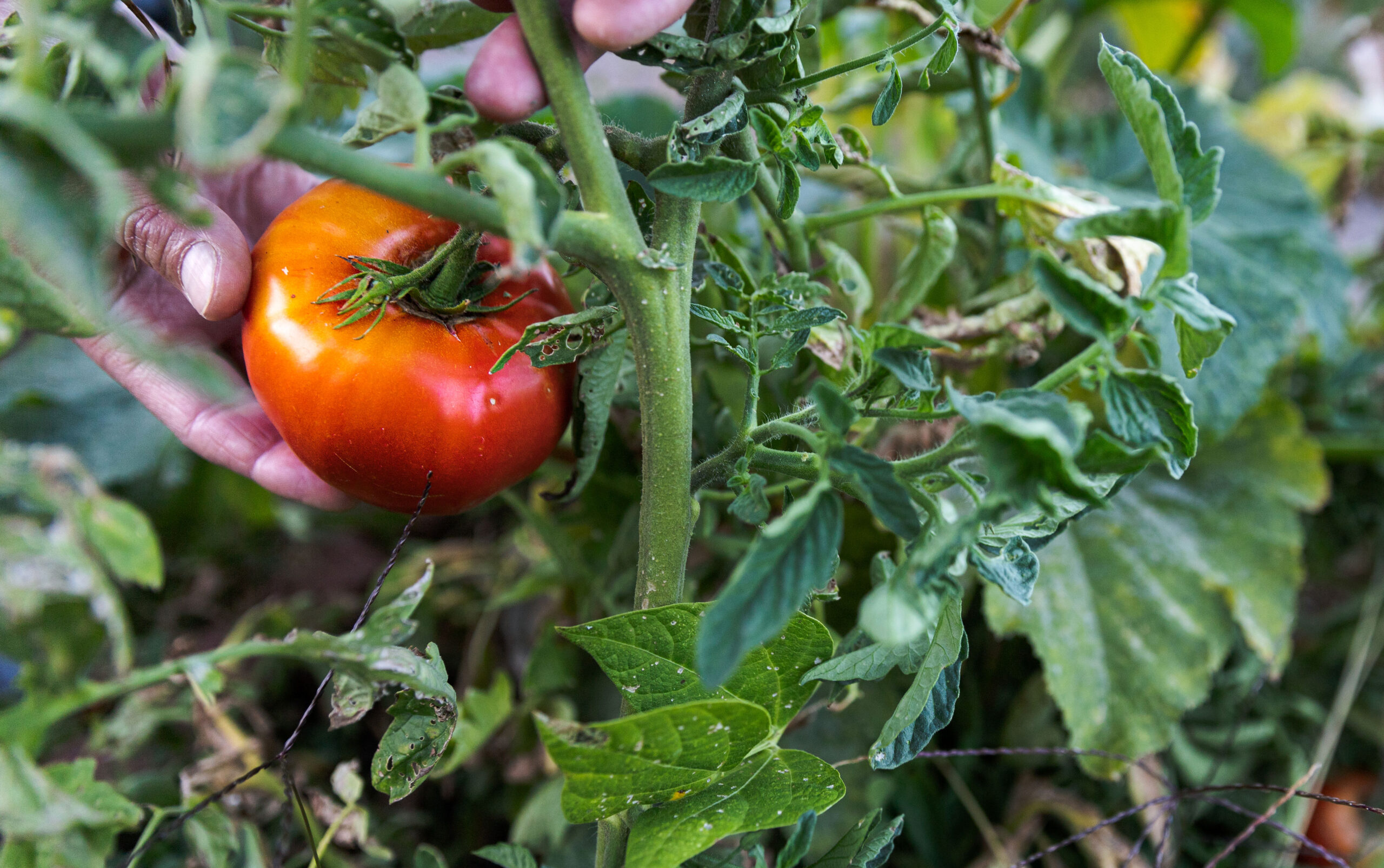Have you ever heard someone mention “determinate” or “indeterminate” tomatoes and wondered what the heck they were talking about?
Whether you’re planting in raised beds, containers, or an in-ground plot, understanding the difference between these two types of tomatoes is key. Both types come with their own needs, advantages, and harvest patterns, and choosing the right one can mean more tomatoes, less stress, and a garden that works with your goals, not against them.
The Basics: What’s the Difference?
Determinate tomatoes—often called “bush” tomatoes—grow to a certain height (usually 3–4 feet), set fruit over a relatively short period, and then stop growing. They produce most of their fruit within a few weeks, making them ideal for gardeners who want a concentrated harvest, such as for canning or preserving.
Indeterminate tomatoes, by contrast, are “vining” varieties. They continue to grow, flower, and produce fruit until killed by frost. They can reach 6 feet or taller and require regular pruning and staking or caging. These tomatoes provide a steady trickle of fruit throughout the summer and early fall.
Timing: Season Length and Denver’s Short Growing Window
Denver’s Front Range climate poses a challenge: short growing seasons, intense sun, and sudden hailstorms. The average frost-free growing period in Denver is about 150 days, typically from mid-May to late September. That’s enough time for tomatoes to mature—but just barely, depending on the variety.
Determinate Advantage: Because determinate tomatoes mature faster—many are ready to harvest in 65–75 days—they’re a great fit for gardeners aiming to beat the first fall frost. They’re ideal for gardeners planting later in the season or working with cool spring soil, since you’re more likely to get a full harvest even if the season is cut short.
Indeterminate Consideration: Indeterminate varieties can take 80–100+ days to reach full maturity, which means they may not produce ripe fruit until August. In Denver’s unpredictable fall, you may need to protect these plants from early frost with row cover or harvest tomatoes green if we get a sudden early fall snow.
Spacing and Location: Fitting Tomatoes Into Your Garden Layout
Determinate tomatoes have a compact, bushy shape, making them perfect for container gardens, raised beds, or tight spaces. Their smaller size also means they’re less likely to suffer damage from Denver’s strong summer winds or hailstorms. They need only light support—usually a tomato cage or short stake will suffice.
Indeterminate tomatoes, however, require more vertical space and structural support. Left unpruned, they’ll sprawl across your garden and shade out nearby plants. In Denver’s arid climate, training them upward using trellises, tall cages, or sturdy stakes not only saves space but also improves airflow and reduces fungal diseases like early blight, which can otherwise take hold during our occasional wet spells.
Yield: Bulk vs. Season-Long Harvest
If your goal is to make sauce, salsa, or preserve your harvest, determinate varieties are the way to go. Their synchronized fruiting means you’ll have a large harvest all at once—perfect for batch cooking or freezing. Some gardeners even do two plantings of determinate tomatoes: one early and one mid-season for a second flush before fall.
However, if you want fresh tomatoes for slicing all summer long, indeterminate varieties are your best bet. They offer a slow-and-steady supply of fruit that can last from mid-late July until the first frost. In Denver’s sunny summers, indeterminates often produce abundant fruit as long as they’re well-fed, watered consistently, and pruned regularly.
Other Considerations for Denver Gardeners
Soil and Heat Management: Tomatoes love heat, but Denver’s intense sun and high-altitude dryness can be harsh. Mulching around the base of both types of plants helps retain moisture and regulate soil temperature. Determinate plants, being lower to the ground, benefit even more from mulch and ground cover, which can help prevent sunscald and dry-out. Indeterminates, especially when grown vertically, benefit from shade cloth during extreme heat waves to protect ripening fruit from sunburn.
Hail Protection: Given Denver’s notorious summer hailstorms, determinates may be slightly less vulnerable due to their shorter stature and bushier habit. Indeterminates, with their exposed vertical growth, are more likely to sustain damage. Savvy gardeners use hoop tunnels with floating row cover or shade cloth for both types during the late spring/early summer storm season.
Pruning and Maintenance: Determinate tomatoes generally require less work. Because they stop growing once they set fruit, pruning is minimal—just remove suckers low on the plant as needed. Indeterminate tomatoes, however, need regular pruning of suckers and lower leaves to manage disease and encourage larger fruit. This ongoing attention can be a plus or minus depending on how much time you want to spend tending your plants.
Recommended Varieties for the Front Range
Determinate:
- Roma: Classic paste tomato, productive and early.
- Bush Early Girl: Great for containers, matures quickly.
- Celebrity: Disease-resistant and reliable.
- Patio Princess: Perfect for small pots and balconies.
Indeterminate:
- Brandywine: Large heirloom with rich flavor.
- Sungold: Sweet cherry tomato, great yield.
- Cherokee Purple: A beloved slicing tomato.
- Better Boy: Vigorous and consistent producer.






Final Thoughts
Both determinate and indeterminate tomatoes have their advantages for the Colorado gardener. Our recommendation? Grow both. A few bushy determinates for early and bulk harvests, plus a couple of well-supported indeterminates for late-summer snacking, offer the best of both worlds—and a steady tomato supply from late July until the end of the season.

